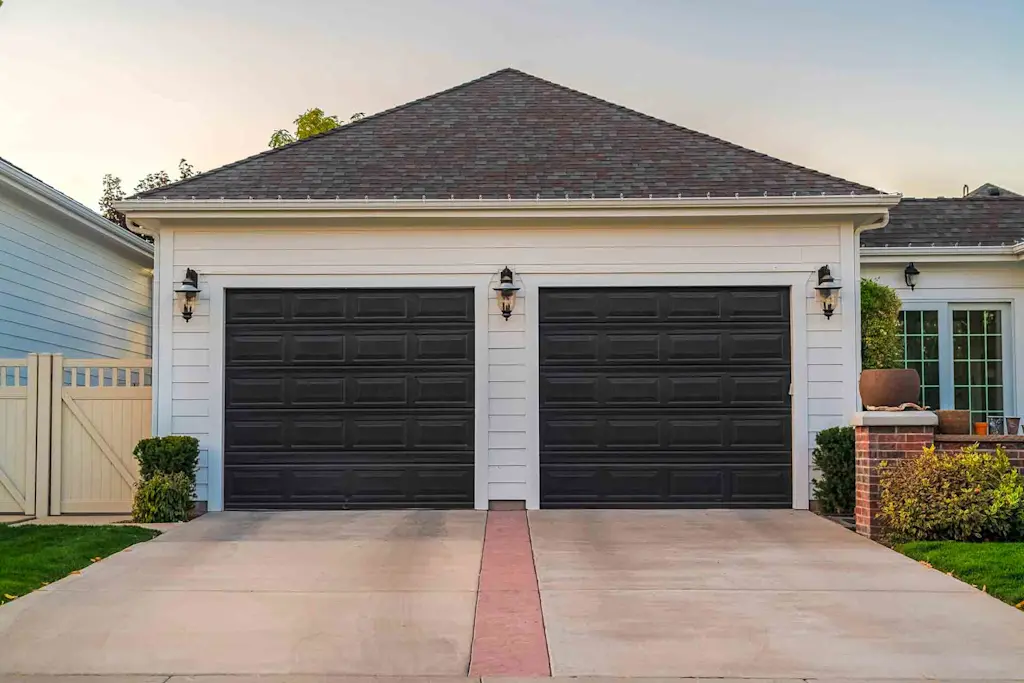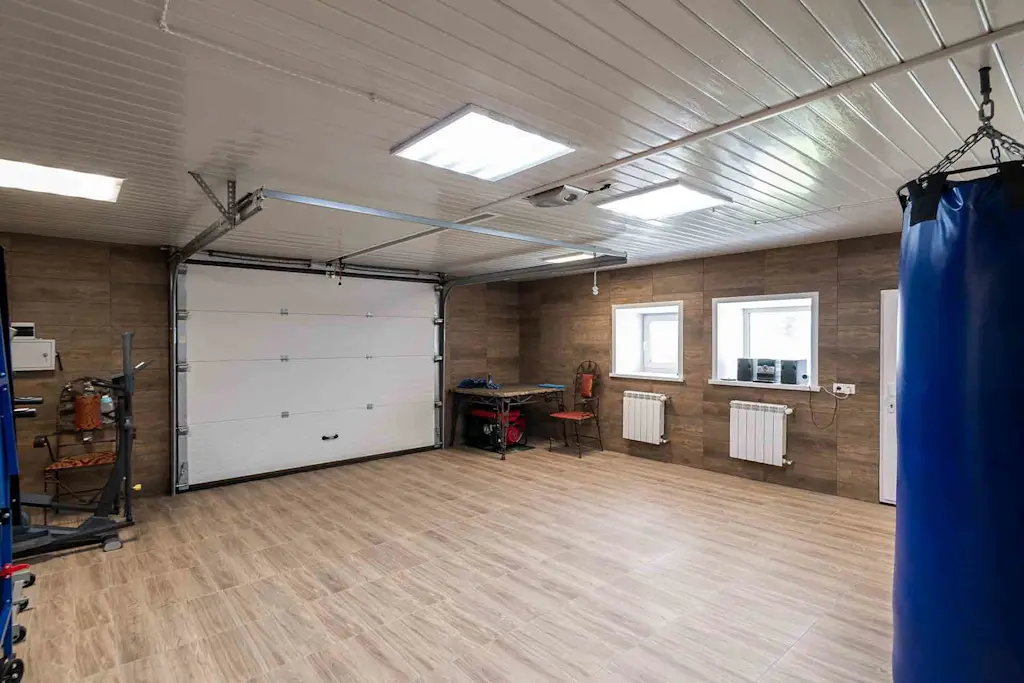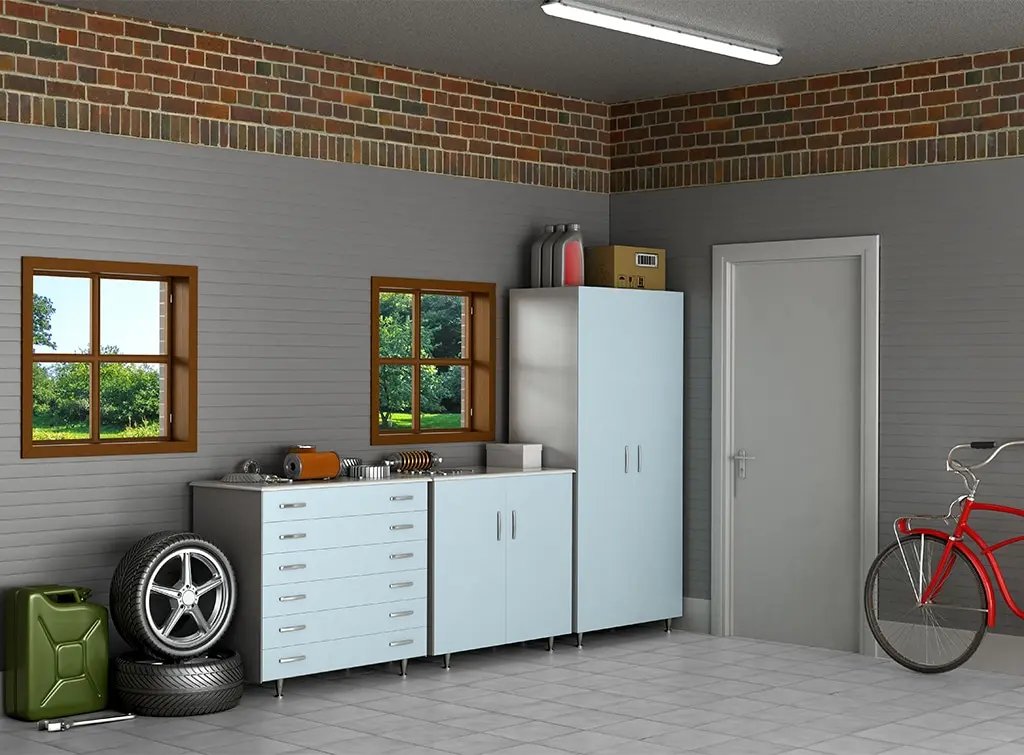Blog>Expert Advice>Buying guide: Helping you to choose your garage lighting
Last updated: 24 September 2024
Buying guide: Helping you to choose your garage lighting
Garage lighting needs to be practical over everything, but style can be important too. So how do you choose the best garage lighting to tick all your boxes? We explain what you need to know in this handy buying guide.

When choosing garage lighting options, it's important to consider both interior and exterior solutions.
Whether you're looking to up your home security, add some lighting for when parking your car, or install lighting for DIY projects and hobbies, we've got you covered.
We explain the different types of garage light fixtures, their uses, what to look for in terms of brightness and coverage, and more.
The importance of garage lighting
Garage lighting serves several key roles - both inside and out.
Good lighting is essential inside the garage from a practical point of view—for general visibility and functionality—in much the same way it's needed in any other room of your house.
Exterior garage lights play an important role in home security and provide safer access at nighttime.
See the tradespeople we've checked and recommend for your job
Types of garage lighting
Broadly, garage lighting can be categorised into three main areas: general lighting, task lighting, and security lighting. You may choose a combination of these lighting solutions, depending on your needs. Let's get into it.
1. General lighting
General lighting does what it says on the tin, lighting up the entire space for good visibility. This is essential for parking the car or accessing the garage after dark, for example.
Popular garage light fixtures that provide even, widespread illumination include:
Recessed ceiling downlights: Set into the ceiling at regular intervals to light up the inside of the garage and avoid dark spots
LED battens: A more energy-efficient and longer-lasting version of traditional fluorescent tube lights dispersing light evenly over a large area
LED panels: Flat, square-shaped lighting panels with integrated LED chips to provide bright, even light distribution - can be surface-mounted on the ceiling or walls
Tip: A motion sensor indoor light can be particularly helpful when entering or exiting the garage with your hands full.

2. Task lighting
Again, there's a clue in the name - task lighting's primary purpose is to help complete specific tasks, be it DIY, working with tools, or tinkering with bikes and equipment.
Types of task lighting in a garage include:
Spotlights: Spotlights can either be mounted to the ceiling as a single fixture or as up to four spotlights on a track or bar - the heads can be tilted to direct the light where needed
Track lighting: Often found in a commercial setting, track lighting has multiple adjustable lights attached to a wall or ceiling-mounted track, to give maximum flexibility
Garage wall lighting: Positioned on the wall to provide softer lighting (this is great if your garage is used as a hangout space or for hobbies such as darts)
Under cabinet lighting: LED strip lights can be installed under wall cabinets to provide brighter light above a workstation

3. Security lighting
Exterior garage lights are essentially for safety and security, illuminating your driveway to improve visibility and deter intruders after dark.
Popular types of security lights for a garage include:
Floodlights: Floodlights provide a bright, widespread beam of light, typically activated by a sensor that detects motion
Wall lights: Wall lights, or wall sconces are a more decorative security light option and can also be equipped with a motion sensor

See the tradespeople we've checked and recommend for your job
How to choose the best garage lighting for your home
We've covered the various types of interior and exterior lighting for a garage, but what else should you consider before making your purchase?
Style and design
There are several different styles and designs of garage lighting - both indoor and out - so it's often best to be guided by the purpose they'll serve in your garage.
For a garage that's mainly used for parking and storage, many homeowners opt for general lighting via LED batten lights.
However, if the garage doubles as a workshop or hobby room, brighter task lighting such as spotlights, wall lights, and under-cabinet lights can be added to specific areas.
Outside, wall lights are a popular option. Equipped with motion sensors, they're arguably more aesthetically pleasing than a floodlight.
Chrome or white finishes and clean lines are well-suited to modern homes
Matt black and metallic accents suit a wide variety of property types
Lantern-style lights look great on a cottage or older-style property
Ultimately, as long as your garage lighting serves its purpose, it's purely down to your personal preference for which style you choose.
Garage size
As you edge closer to making your selection, you may be wondering how many lights you need in a garage. Typically, this is dictated by the size of the space.
As standard, install a light for every 4-6 feet of ceiling space to make sure the garage is evenly lit.
Remember to account for ceiling height. For a garage with a low ceiling, lights that sit flush to the ceiling are best.
For a garage with an 'up and over' door, make sure there's adequate clearance between the door and the light fixtures you choose.

Brightness
The level of brightness you need for garage lights depends on their purpose. Precision DIY tasks need brighter light than simply accessing the room, for example.
Brightness is measured in lumens - the higher the figure, the brighter the light. As a general rule, aim for:
1,300 lumens for security lighting
300 lumens per sq ft above a workstation
50-100 lumens along a side access path
50-75 lumens per sq ft for general interior lighting
If your garage is 200 sq ft., using the figures above as a guide, we estimate 50 lumens per sq ft is needed for general lighting, meaning 10,000 lumens will be needed in total.
Colour temperature
If you've ever struggled to get the right colour light bulbs in your home, you'll understand the importance of colour temperature.
Colour temperature is measured in Kelvins. It's the difference between the cosy glow of hallway lighting and the brighter illumination of a bathroom. Here's what to look for:
Neutral white light (3,000-4,000K): Is best for general garage lighting
Cool white (4,000-5,000K): More suitable for task lighting above a garage workspace
Daylight (5,000-6,500K): Often used for security lighting
See the tradespeople we've checked and recommend for your job
Energy efficiency and smart technology
Energy efficiency, convenience, and safety are other considerations to make when choosing your garage lighting.
LED bulbs
LED bulbs are the go-to option in modern homes. They use up to 90% less energy than traditional incandescent bulbs and can last 30% longer, making them a cost-effective option. Fluorescent tube lights are harder to find nowadays, with LED battens and panels being more popular with UK homeowners.
Smart technology
Smart lighting helps you manage your lights remotely, adjust brightness, or set schedules to ensure the lights come on and off when you need them. This can be particularly useful if you're away on holiday and want to schedule your garage lights to turn on and off to give the impression someone is home.
Motion sensor lights
Motion sensor lights automatically turn on and off as motion is detected in the given area. This is great for energy efficiency and convenience, but also for home security.
As is the case with garden lighting, sensors are built into some types of lights, acting as a trigger for them to turn on and off. This can be particularly useful in garage wall lights and floodlights.
PIR (Passive Infrared) sensors turn the light on when heat is detected
Photocell sensors turn the light on at dusk and off at dawn
Timers can also be used to set your garage lights to turn on and off at certain times
Safety and IP ratings
A final, but important note, about safety and IP ratings.
Lighting carries an IP rating. This indicates how well a light fixture resists solid and liquid objects. In the case of garage lighting, you're mainly looking at dust and water. They use the initials 'IP' followed by two numbers.
The first number shows its protection rating against solid objects. The second number indicates water resistance. The higher the number, the more protection, which means you'll have a different rating for interior and exterior garage lights, for example.
IP20 is the minimum rating for an interior garage light
IP44 is ok for lights exposed to light rain
IP65 or higher is the ideal level of protection for outdoor lighting exposed to heavy rain
Fire protection
If you select recessed ceiling downlights in your garage, check that they are fire-rated. This means they are designed to restore the ceiling’s fire integrity by sealing off the hole where the downlight is installed.
Contact or pay a trade through Checkatrade and you’re covered by our 12-month guarantee of up to £1,000*

How much does garage lighting installation cost?
On average, it costs around £165 to install a single low-voltage wall light
The average cost to install an outdoor security light is £150. More powerful 30W versions may cost £175 to install
Electricians tend to charge between £45 - £60 per hour
The cost of garage lighting will vary depending on the scope of the work needed, the type and quality of the fixtures you choose, and the complexity of the installation.
For an accurate quote, contact a qualified local electrician.
Why not consider some garden lighting?
Garage lighting often serves a predominantly functional purpose, but how about installing some garden lighting to upgrade your outside space? Decking lights, path lights, or even pond lights can make a great addition.
As a guide, expect to pay in the region of £400for the installation of ten LED light clusters (plugged into an existing socket along with 65 metres of cable).
Request a quote for your lighting project
For any lighting installation project, it's best to hire a qualified electrician. Get direct quotes from our approved members through our request a quote feature.

On Checkatrade, you'll only find trades who meet our high standards and pass up to 12 checks.
Key takeaways
Garage lighting falls into three main categories: general lighting, task lighting, and security lighting
The average cost to install an outdoor security light is £150
Choose from a selection of garage lighting types including LED batten lights, spotlights, recessed downlights, wall lights, and floodlights
Consider IP ratings, bulb brightness, colour, and the purpose the lights need to serve when making your selection
LED lights are the preferred option for garage lights being energy-efficient, safe, and long-lasting
Always hire a qualified electrician to install your garage lighting for a safe and competent installation

Find a qualified electrician in your area
Search your postcode below to find highly rated tradespeople in your area.
See the tradespeople we've checked and recommend for your job
FAQs
What lighting is best for a garage?
LED batten lights make a great choice for general lighting inside a garage. They are energy-efficient and long-lasting. Floodlights and wall lights are popular options for improving security outside a garage.
How to choose garage lighting?
Consider the purpose you need the lighting to serve. For workspaces, brighter task lighting is best. For general illumination, LED batten lights make a good choice.
Are LED lights good for garages?
Yes, LED lights are ideal for garages. They are rapidly replacing fluorescent tube lights as a more energy-efficient and longer-lasting option.
How many lights do you need in a garage?
Aim to install a light every 4-6 ft of ceiling space to ensure the whole garage is evenly lit.
What are the best exterior garage lights?
Motion sensor floodlights and wall lights are best suited for the exterior of a garage. They help deter intruders and improve visibility after dark.
See the tradespeople we've checked and recommend for your job


